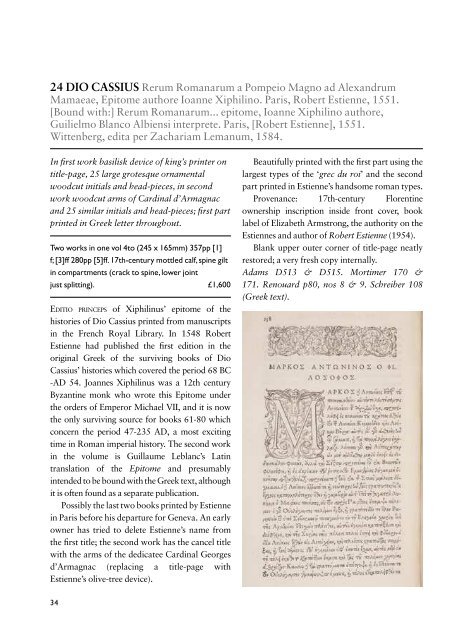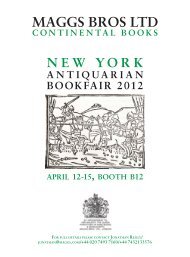CONTINENTAL BOOKS CATALOGUE 1448 - Maggs Bros. Ltd.
CONTINENTAL BOOKS CATALOGUE 1448 - Maggs Bros. Ltd.
CONTINENTAL BOOKS CATALOGUE 1448 - Maggs Bros. Ltd.
Create successful ePaper yourself
Turn your PDF publications into a flip-book with our unique Google optimized e-Paper software.
24 DIO CASSIUS Rerum Romanarum a Pompeio Magno ad Alexandrum<br />
Mamaeae, Epitome authore Ioanne Xiphilino. Paris, Robert Estienne, 1551.<br />
[Bound with:] Rerum Romanarum... epitome, Ioanne Xiphilino authore,<br />
Guilielmo Blanco Albiensi interprete. Paris, [Robert Estienne], 1551.<br />
Wittenberg, edita per Zachariam Lemanum, 1584.<br />
In first work basilisk device of king’s printer on<br />
title-page, 25 large grotesque ornamental<br />
woodcut initials and head-pieces, in second<br />
work woodcut arms of Cardinal d’Armagnac<br />
and 25 similar initials and head-pieces; first part<br />
printed in Greek letter throughout.<br />
Two works in one vol 4to (245 x 165mm) 357pp [1]<br />
f; [3]ff 280pp [5]ff. 17th-century mottled calf, spine gilt<br />
in compartments (crack to spine, lower joint<br />
just splitting). £1,600<br />
editio princeps of Xiphilinus’ epitome of the<br />
histories of Dio Cassius printed from manuscripts<br />
in the French Royal Library. In 1548 Robert<br />
Estienne had published the first edition in the<br />
original Greek of the surviving books of Dio<br />
Cassius’ histories which covered the period 68 BC<br />
-AD 54. Joannes Xiphilinus was a 12th century<br />
Byzantine monk who wrote this Epitome under<br />
the orders of Emperor Michael VII, and it is now<br />
the only surviving source for books 61-80 which<br />
concern the period 47-235 AD, a most exciting<br />
time in Roman imperial history. The second work<br />
in the volume is Guillaume Leblanc’s Latin<br />
translation of the Epitome and presumably<br />
intended to be bound with the Greek text, although<br />
it is often found as a separate publication.<br />
Possibly the last two books printed by Estienne<br />
in Paris before his departure for Geneva. An early<br />
owner has tried to delete Estienne’s name from<br />
the first title; the second work has the cancel title<br />
with the arms of the dedicatee Cardinal Georges<br />
d’Armagnac (replacing a title-page with<br />
Estienne’s olive-tree device).<br />
Beautifully printed with the first part using the<br />
largest types of the ‘grec du roi’ and the second<br />
part printed in Estienne’s handsome roman types.<br />
Provenance: 17th-century Florentine<br />
ownership inscription inside front cover, book<br />
label of Elizabeth Armstrong, the authority on the<br />
Estiennes and author of Robert Estienne (1954).<br />
Blank upper outer corner of title-page neatly<br />
restored; a very fresh copy internally.<br />
Adams D513 & D515. Mortimer 170 &<br />
171. Renouard p80, nos 8 & 9. Schreiber 108<br />
(Greek text).<br />
25 ERASMUS Moriae Encomium [in Greek, then] Stultitiae Laus.<br />
Cum commentariis Ger. Listrii, & figuris Jo Holbenii. E codice Academiae<br />
Basiliensis... Basle, typis Genathianis, 1676.<br />
Engraved title-page, added, by Kaspar Merian<br />
after Hans Holbein, engraved device on title,<br />
engraved vignette above dedication to Colbert<br />
incorporating his ‘snake’ insignia, engraved<br />
portrait of Erasmus, and two of Hans Holbein,<br />
full-page engraving of Erasmus’ epitaph, and 82<br />
engravings by Merian after Holbein, some<br />
pressed directly into the text and the larger ones<br />
pasted in on folding slips (a little browned).<br />
8vo (194 x 116mm) [40]ff 336pp [6]ff. Contemporary<br />
panelled calf, spine gilt in compartments, red morocco<br />
label (rebacked with original spine laid down). £1,250<br />
First edition of In Praise of Folly to hold the famous<br />
illustrations of Hans Holbein and his brother<br />
Ambrosius. They are here engraved by Kaspar<br />
Merian from the original marginal illustrations,<br />
Holbein’s earliest surviving work, found in a copy<br />
of the 1515 edition now at the Kunstmuseum at<br />
Basle. The editor Charles Patin also adds a life of<br />
Holbein, not always complementary, and the first<br />
catalogue raisonné in which he describes 60 works<br />
over five pages in double columns.<br />
This edition also includes a life of Erasmus<br />
and bibliography, the commentary of Gerard<br />
Lister (which Erasmus also worked on),<br />
Erasmus’ preface to Thomas More, with whom<br />
he stayed in 1509 and wrote In Praise of Folly as<br />
a diversion from a kidney ailment, and letters to<br />
More and Martin van Dorp<br />
Van der Haeghen p122.<br />
34 35






